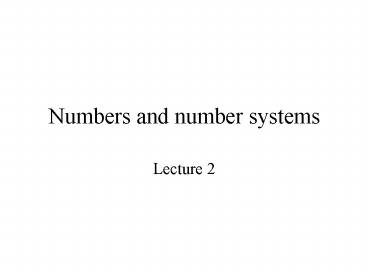Numbers and number systems - PowerPoint PPT Presentation
Title:
Numbers and number systems
Description:
To make the computer hardware simple and reliable, computers represent ... 4 is the LSD. 1. 0. 0. 1. 0. 0. 1. 1. 20. 21. 22. 23. 24. 25. 26. 27. weight ... – PowerPoint PPT presentation
Number of Views:28
Avg rating:3.0/5.0
Title: Numbers and number systems
1
Numbers and number systems
- Lecture 2
2
Some material from the last lecture
- Electronic computers represent information as
voltage levels. - To make the computer hardware simple and
reliable, computers represent information in
binary form. - example voltages greater than 3V are interpreted
as representing one value (called 1), voltages
less than 2V are interpreted as representing
another value (called 0). - In principle, could use more voltage levels.
- example 0 to .75V represents 0, 1 to 1.75V
represents 1, 2 to 2.75V represents 2, and so
forth. - In practice, this is rarely done.
- requires more complex circuits
- circuits are more susceptible to noise, hence
less reliable
3
Some material from the last lecture
- Computers, like all electronic systems, are
affected by noise. - noise has various sources (nearby signal changes,
thermal vibrations of molecules in semiconductor
materials, . . . ) - in computers, noise can cause binary
- signals to be misinterpreted
- The noise margin is the amountof noise that a
system cantolerate and still correctlyidentify
a logic high or low.
4
Radix number systems
- Some number of positions and some number of
symbols - The number of positions varies by context
- The number of symbols is a property of the number
system - Decimal -- 10 symbols
- Binary -- 2 symbols
- Octal -- 8 symbols
- Hexadecimal -- 16 symbols
5
Start with whole numbers
- Each position has a value
- Each symbol has a value
- Multiply the value of the symbol by the value of
the position, then add - In decimal, 3874 means
- 3 times 1,000
- plus 8 time 100
- plus 7 times 10
- plus 4 times 1
6
Decimal, binary, octal, hex
- In decimal there are 10 symbols (0..9) and the
value of each position is a power of 10. - 100 1 value of the units position
- 101 10 value of next position to the left
- etc.
- In binary, there are 2 symbols, 0 and 1, and the
value of each position is a power of 2. - In octal, 8 symbols, and powers of 8
- In hexadecimal, 16 symbols, and powers of 16
7
Most Significant digit
Decimal Number 378.4
Least Significant digit
Weight
3 7 8 4
. is called the radix point 3 is the MSD 4 is the
LSD
8
Least Significant bit
Most Significant bit
weight 27 26 25 24 23 22 21 20
1 1 0 0 1 0 0 1
110010012 1?27 1?26 1?23 1?20 201
Least Significant bit
Most Significant bit
weight 25 24 23 22 21 20 2-1 2-2
1 1 0 0 1 0 0 1
110010.012 1?25 1?24 1?21 1?2-2 50.25
9
K, M and G
- 210 is referred as K (kilo)
- 220 is referred as M (mega)
- 230 is referred as G (giga)
10
Trinary Numbers
Trinary number 110010023
weight 37 36 35 34 33 32 31 30
1 1 0 0 1 0 0 2
110010013 1?37 1?36 1?33 2?30 2945
11
Octal Numbers
Octal number 127.48
weight 82 1 81 2 80 7 8-1 4
82 1 81 2 80 7 8-1 4
110010013 1?82 2?81 7?80 4?8-1 87.5
12
Hexadecimal Numbers
Hex Dec
0 0
1 1
2 2
3 3
4 4
5 5
6 6
7 7
8 8
9 9
A 10
B 11
C 12
D 13
E 14
F 15
Hexadecimal number FA9H
weight 162 161 160
F A 9
FA9H 15?162 10?161 9?160 4009
13
Things to do
- Review from your class notes what we discussed
today. - Conversions between Number Systems
- Binary, octal and hexadecimal
- Solve 1-6 before coming to the
- class































